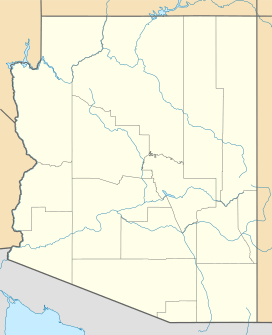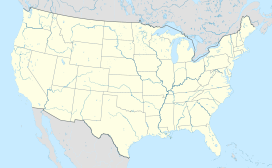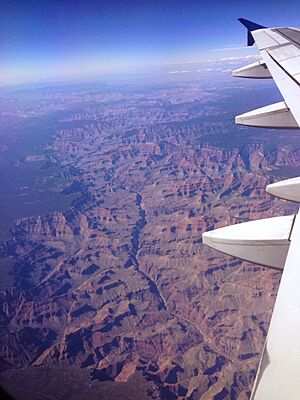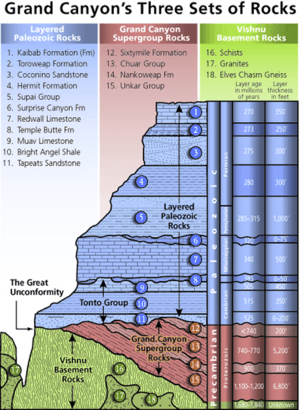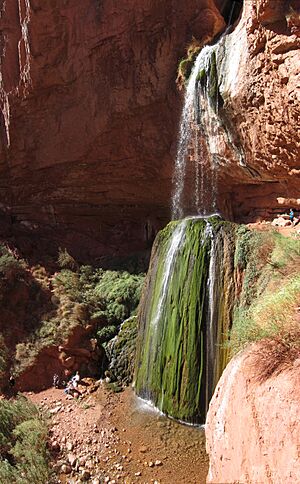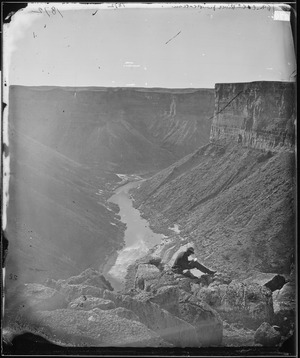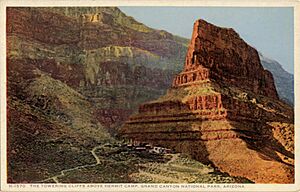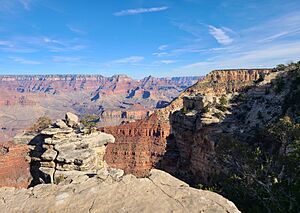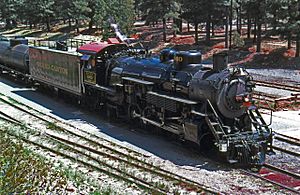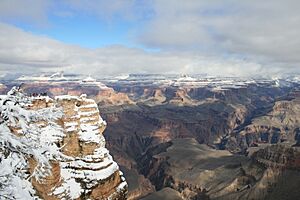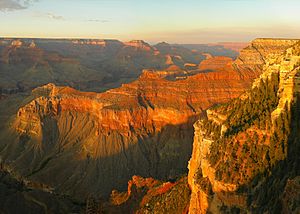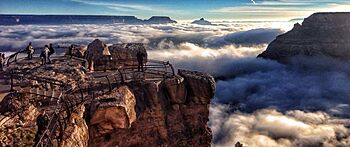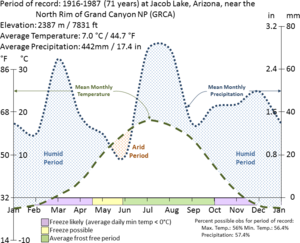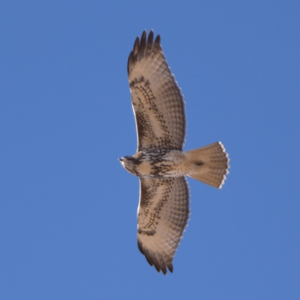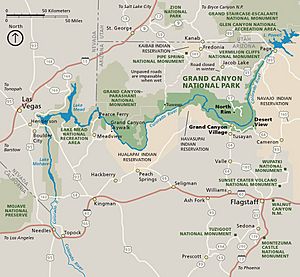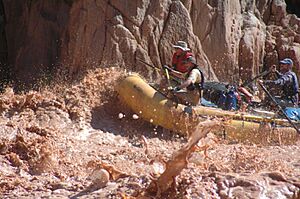Grand Canyon facts for kids
Quick facts for kids Grand Canyon |
|
|---|---|

The Colorado River flowing through the Grand Canyon in Arizona
|
|
| Floor elevation | Approx. 2,600 ft (800 m) |
| Length | 277 mi (446 km) |
| Width | 4 to 18 mi (6.4 to 29.0 km) |
| Geology | |
| Age | 5–6 million years |
| Geography | |
| Location | Arizona |
| Country | United States |
| Rivers | Colorado River |
The Grand Canyon is a huge, steep-sided canyon carved by the Colorado River in Arizona, United States. It is 277 miles (446 km) long and up to 18 miles (29 km) wide. At its deepest, the canyon is over a mile (6,093 feet or 1,857 meters) deep.
This amazing natural wonder and the land around it are protected within Grand Canyon National Park, the Kaibab National Forest, and other special areas. President Theodore Roosevelt loved the Grand Canyon and worked hard to protect it. He visited many times to enjoy its beauty.
Scientists believe the Grand Canyon was formed over millions of years. The Colorado River and its smaller streams slowly cut through layers of rock. This happened while the Colorado Plateau was slowly pushed upwards. Most experts think the Colorado River started carving its path through this area about 5 to 6 million years ago. Since then, the river has continued to deepen and widen the canyon.
For thousands of years, Native Americans have lived in the Grand Canyon area. They built homes inside the canyon and its many caves. The Pueblo people saw the Grand Canyon as a sacred place. They often made special journeys there. The first European to see the Grand Canyon was García López de Cárdenas from Spain in 1540.
Contents
- Exploring the Grand Canyon's Geography
- Understanding Grand Canyon Geology
- Water in the Grand Canyon: Hydrology
- A Look at Grand Canyon History
- Historic Buildings on the South Rim
- Grand Canyon Weather and Climate
- Grand Canyon's Amazing Plants and Animals
- Grand Canyon Tourism and Activities
- See also
- Images for kids
Exploring the Grand Canyon's Geography
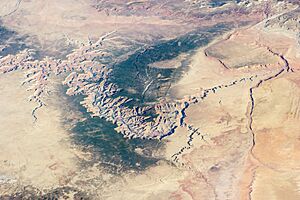
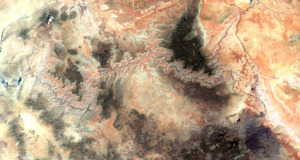
The Grand Canyon is a large river valley located in the Colorado Plateau. It shows off very old rock layers that have been pushed up over time. While it's not the deepest canyon in the world, it is famous for its incredible size and beautiful, colorful scenery. Geologists find it important because of the many layers of ancient rocks. These rocks tell a lot about the early history of the North American continent.
The land around the canyon, called the Colorado Plateau, was lifted thousands of feet high. This higher elevation brings more rain and snow to the Colorado River area. However, it's still a very dry place. The North Rim of the canyon is about one thousand feet (300 m) higher than the South Rim. Because of this, the North Rim gets more rain and snow. This creates deeper and longer side canyons on the north side. The south side has shorter and steeper canyons.
Temperatures on the North Rim are usually colder than on the South Rim. This is because the North Rim is higher, averaging 8,000 feet or 2,400 meters above sea level. Heavy rains are common on both rims during summer. Getting to the North Rim can be difficult in winter. The main road, State Route 67, often closes due to snow.
Understanding Grand Canyon Geology
The Grand Canyon shows one of the most complete collections of rock layers on Earth. There are almost 40 main layers of sedimentary rock visible. These rocks range in age from about 200 million to nearly 2 billion years old.
Most of these layers formed in warm, shallow seas. Some layers even show ancient sand dunes from an old desert. There are at least 14 known "unconformities" in the canyon's rocks. An unconformity is a gap in the rock record, showing a time when rocks were eroded away instead of being laid down.
The oldest rocks at the bottom of the canyon are nearly 2 billion years old. The youngest rocks at the top of the rim are about 230 million years old. The huge depth of the Grand Canyon was created by the Colorado Plateau being lifted up. This uplift started about 65 million years ago. This made the Colorado River flow faster and cut through the rock more quickly.
During the ice ages, the Colorado River had even more water. This helped it cut its channel faster and deeper. About 5.3 million years ago, the Gulf of California opened. This lowered the river's lowest point, speeding up erosion. Most of the canyon's current depth was carved by 1.2 million years ago. The stepped look of the canyon walls comes from different rocks resisting water flow in different ways.
Between three million and 100,000 years ago, volcanic activity happened in the area. Lava and ash sometimes completely blocked the river. These volcanic rocks are the newest in the canyon.
Water in the Grand Canyon: Hydrology
Groundwater is water that soaks into the earth from rain and snow. It collects underground in layers of rock called aquifers. Some rock layers, called aquitards, are less permeable. This means water cannot easily flow through them.
The Grand Canyon has two main aquifers where groundwater collects. The higher C-aquifer collects water that seeps through the top rock layers. Below it, the R-aquifer, also called the Redwall-Muav aquifer, is a karst aquifer. This means it has many cracks and caves where water flows.
Water from these aquifers often comes out as springs and seeps in the canyon walls. These springs are important sources of water for plants and animals. Studies show that some groundwater in the canyon is very old, even up to 20,000 years old. Other water is much younger, coming from recent snowmelt and rain.
A Look at Grand Canyon History
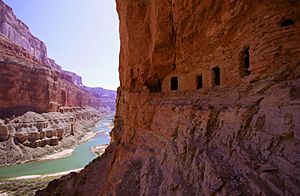
Native American Life in the Canyon
The Ancestral Puebloans were among the first people known to live in the Grand Canyon area. They were an ancient culture centered in the Four Corners region of the United States. Today's Pueblo people are their descendants.
Archaeologists believe this culture started around 1200 BCE. Besides the Ancestral Puebloans, many other groups lived here. The Cohonina lived west of the canyon from 500 to 1200 CE. They are ancestors of the Yuman, Havasupai, and Hualapai peoples who live there today.
The Sinagua lived southeast of the canyon from about 500 to 1425 CE. They may be ancestors of some Hopi clans. By the 1500s, new cultures had developed. The Hualapai live along the southern side of the canyon. The Havasupai have lived near Cataract Canyon since the 1200s. The Southern Paiutes live in parts of Utah and Arizona. The Navajo (Diné) live in a wide area stretching east from the San Francisco Peaks.
Some Hopi stories say the Grand Canyon was the place where humankind first came into this world.
European Exploration and Settlement
Spanish Explorers Reach the Canyon
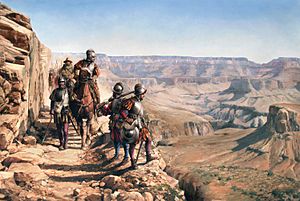
In September 1540, Captain García López de Cárdenas was sent by Francisco Vázquez de Coronado. He was looking for the fabled Seven Cities of Cibola. With Hopi guides and Spanish soldiers, he reached the south rim of the Grand Canyon. Some of his men tried to go down but had to turn back due to lack of water. They said some rocks were "bigger than the great tower of Seville." It's thought the Hopi guides knew how to reach the river but didn't want to show the Spanish. No other Europeans visited for over 200 years.
In 1776, two Spanish priests, Fathers Francisco Atanasio Domínguez and Silvestre Vélez de Escalante, explored the north rim. They were looking for a route from Santa Fe to California. They found a crossing that is now under Lake Powell. Also in 1776, Fray Francisco Garces, a missionary, spent a week near Havasupai. He tried to convert Native Americans but was not successful. He described the canyon as "profound."
American Explorers Discover the Canyon
James Ohio Pattie, an American trapper, may have been the next European to reach the canyon in 1826.
Jacob Hamblin, a Mormon missionary, was sent in the 1850s to find good river crossing spots. He built good relationships with local Native Americans and settlers. He helped John Wesley Powell before Powell's second trip to the Grand Canyon. Hamblin acted as a diplomat to ensure Powell's safety.
In 1857, Edward Fitzgerald Beale led an expedition to survey a wagon road. His group found the canyon and described it as "a wonderful canyon; four thousand feet deep." Also in 1857, Lieutenant Joseph Ives led an expedition to see if the Colorado River could be navigated. He traveled up the river and explored parts of the canyon.
In 1869, Major John Wesley Powell led the first expedition down the Colorado River and through the Grand Canyon. He and his nine men started from Green River, Wyoming, on May 24. They faced dangerous rapids and lost one boat and a lot of food. They had to survive on very little food.
On August 28, 1869, three men left the expedition, thinking the rapids ahead were too dangerous. Sadly, they were later killed. The remaining members safely passed through the rapids the next day. Powell later became the first to use the term "Grand Canyon" in 1871. Before that, it was called the "Big Canyon."
The Grand Canyon became an official national monument in 1908. It was made a national park in 1919.
Protecting the Grand Canyon: National Monument and Park
U.S. President Theodore Roosevelt visited the Grand Canyon in 1903. He loved the outdoors and worked to protect nature. In 1906, he created the Grand Canyon Game Preserve. He also helped form the National Parks Association. This group pushed for the Antiquities Act of 1906. This act gave Roosevelt the power to create national monuments.
On January 11, 1908, Roosevelt made the preserve a U.S. National Monument. It took 11 more years for it to become a U.S. National Park. President Woodrow Wilson signed the law on February 26, 1919. The Grand Canyon became the 17th U.S. National Park.
Managing the park has challenges. These include protecting the endangered California condor. There are also issues with noise from air tours and managing water rights.
The canyon's environment changed after the Glen Canyon Dam was built in 1963. Natural floods stopped, which caused sandbars and beaches to erode. Invasive plants also started to grow. Park officials have tried releasing controlled floods to help restore the environment. However, recent droughts have caused water levels to drop. This has delayed some of these efforts.
There have been concerns about uranium mining near the canyon. Critics worry that mining could pollute the Colorado River. This river provides drinking water for millions of people. In 2012, the U.S. Interior Secretary established a 20-year ban on new uranium mining in the area. This ban was put in place to protect the canyon and its water. Courts have upheld this ban.
In August 2023, President Joe Biden created the Baaj Nwaavjo I’tah Kukveni – Ancestral Footprints of the Grand Canyon National Monument. This protects nearly 1 million acres around the Grand Canyon.
Historic Buildings on the South Rim
There are several old and interesting buildings along the South Rim, especially near Grand Canyon Village.
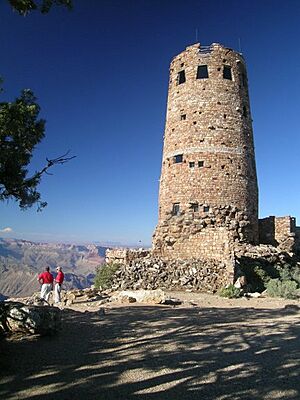
- Buckey O'Neill Cabin was built in the 1890s by William Owen "Buckey" O'Neill. He was a miner, judge, and tour guide. This cabin is the oldest building still standing on the South Rim. Today, it's a guest house.
- Kolb Studio was built in 1904 by brothers Ellsworth and Emery Kolb. They were photographers who took pictures of visitors on the Bright Angel Trail. They also filmed their journey down the Green and Colorado Rivers. Today, the building is an art gallery.
- The El Tovar Hotel was built in 1905 as a fancy hotel for the railway. It looks like a Swiss chalet mixed with local materials. It has four stories, a gift shop, and a restaurant.
- Hopi House was designed by Mary Jane Colter in 1905. It looks like an ancient Hopi village. Hopi people used to live here and sell their arts and crafts to visitors.
- Verkamp's Curios was built in 1905 by John Verkamp. He sold arts, crafts, and souvenirs. Now, it's a visitor center about the history of Grand Canyon Village.
- Grand Canyon Railway Depot was finished in 1910. It's one of only a few log-cabin-style train stations left in the U.S. It's the end point for the Grand Canyon Railway, which starts in Williams, Arizona.
- Lookout Studio, also designed by Mary Colter, was built in 1914. You can buy photos, art, and books here. It also offers a great view of Bright Angel Trail.
- Desert View Watchtower, another famous design by Mary Colter, was built in 1932. It's at the far eastern end of the South Rim, 27 miles (43 km) from Grand Canyon Village. The tower is 70 feet (21 m) tall. From the top, you can see the bottom of the canyon and the Colorado River. It was designed to look like old Ancestral Puebloans watchtowers.
- Bright Angel Lodge was built in 1935 using logs and stone. Mary Colter designed it. Inside, there's a small museum about Fred Harvey, who helped make the Grand Canyon popular.
Grand Canyon Weather and Climate
Weather in the Grand Canyon changes a lot depending on how high you are. The forested rims get snow in winter. But along the Colorado River at the bottom, temperatures are like those in Arizona's deserts. The Grand Canyon region is generally dry. However, it gets a lot of rain twice a year. In winter, storms from the Pacific bring rain and snow. In late summer, moisture from the southeast causes strong thunderstorms.
The South Rim gets less than 16 inches (41 cm) of rain each year, with 60 inches (150 cm) of snow. The higher North Rim usually gets 27 inches (69 cm) of moisture, with about 144 inches (370 cm) of snow. Phantom Ranch, deep in the canyon, gets only 8 inches (200 mm) of rain, and snow is very rare there.
Temperatures change a lot throughout the year. Summer highs in the canyon can go over 100 °F (38 °C). Winter lows on the rims can drop below zero degrees Fahrenheit (−18 °C). Visitors should be ready for these extreme conditions. Dehydration, sunburn, and hypothermia can be risks. Always check the weather forecast before hiking.
Air Quality at the Canyon
The Grand Canyon usually has some of the cleanest air in the United States. However, air quality can be affected by pollution from power plants, mining, cars, and cities. Wildfires and dust storms can also have a big impact.
Visibility is usually best in winter and worst in summer. Winter winds bring clean air, and you can often see up to 210 miles. In summer, winds carry pollution from cities, and visibility is often only 100 miles. Smog can also get trapped inside the canyon.
To improve air quality, steps have been taken. In the 1990s, laws were passed to reduce pollution that affects visibility. Power plants near the canyon have either added special equipment to clean their emissions or have shut down. Controlled fires are also used to manage forests. This helps reduce the risk of large, smoky wildfires.
Climate Change and the Canyon
Temperatures have been rising in Arizona. This is due to an increase in greenhouse gases. Since 1895, temperatures have gone up by 2.1 degrees Fahrenheit. This warming means more water evaporates and there's less snowpack. This reduces the amount of water in the Colorado River.
The South Rim gets about 13.4 inches of rain per year, while the North Rim gets 24 inches. The park uses a special system to treat and reuse wastewater. Water for the South Rim is pumped from underground springs on the North Rim through a pipeline. About 500,000 gallons of water are pumped every day.
As more visitors come to the park, water use increases. The old pipeline needs to be replaced. There are also concerns about the long-term water supply. The park aims to reduce greenhouse gas emissions and adapt to climate change. This includes educating visitors and monitoring progress.
Grand Canyon's Amazing Plants and Animals
Plants of the Canyon
The Grand Canyon is home to many different kinds of plants. There are about 1,737 known species of vascular plants, 167 species of fungi, and many types of moss and lichen. This variety is because of the huge 8,000 foot (2,400 m) change in elevation from the Colorado River to the highest point on the North Rim. The Grand Canyon has a dozen plants found nowhere else in the world.
The western parts of the canyon are influenced by the Mojave Desert. The eastern parts have plants from the Sonoran Desert. On both rims, you can find ponderosa and pinyon pine forests.
Natural springs and seeps in the canyon walls are home to 11% of all the plant species found here. The canyon can also act as a bridge for some species, connecting habitats from east to west. However, for other species, like the tassel-eared squirrel, the canyon can be a barrier.
The direction a slope faces also affects plant life. North-facing slopes get less sunlight. Plants there are similar to those found in colder, higher places. South-facing slopes get full sunlight and have plants typical of the Sonoran Desert.
Animals of the Canyon
Out of the 90 mammal species found along the Colorado River, 18 are rodents and 22 are bats.
Life Zones and Communities
The Grand Canyon National Park has several major ecosystems. It has a great variety of life because it includes five of North America's seven life zones. This is like traveling from Mexico to Canada in terms of climate and plant life. Differences in elevation and climate create these different life zones. The park has 129 different plant communities.
Lower Sonoran Zone
The Lower Sonoran life zone goes from the Colorado River up to 3,500 feet (1,100 m). Along the river, you'll find plants like coyote willow, arrowweed, and western honey mesquite. Rare plants can be found in hanging gardens and springs. Endangered fish like the humpback chub live in the river.

Common amphibians here include the canyon tree frog and red-spotted toad. There are 33 types of tiny crustaceans in the river. Only 48 bird species regularly nest along the river. The bald eagle uses the river corridor in winter.
Beavers cut down trees for food and can change the plants along the river. Other small animals like antelope squirrels and pocket mice eat many different plants. Bats roost in the desert but hunt insects along the river. Coyotes, ringtails, and spotted skunks are common predators here.
Raccoons, weasels, bobcats, gray foxes, and mountain lions are also present but are rarer. Mule deer and desert bighorn sheep visit the river area. After wild burros were removed in the 1980s, bighorn sheep numbers grew.
Common insects include midges, caddisflies, and butterflies. Many types of spiders and scorpions also live here.
There are about 41 reptile species in the park. Lizards and snakes are common along the river. The gila monster and chuckwalla are the two largest lizards. Six types of rattlesnakes have been found in the park.
Above the river, a desert scrub community thrives. Plants like creosote bush, white bursage, and various cacti grow here. This community is home to 50 mammal species, mostly rodents and bats. The desert gopher tortoise, a threatened species, lives in these scrublands.
Upper Sonoran and Transition Zones
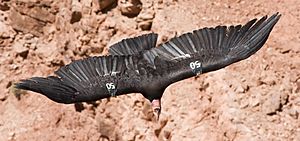
The Upper Sonoran Life Zone covers most of the inner canyon and South Rim, from 3,500 to 7,000 feet (1,100 to 2,100 m). This area has blackbrush, sagebrush, and pinyon-juniper woodlands. You can find plants like Utah agave and various cacti.
About 30 bird species breed in the inner canyon's desert uplands and cliffs. Peregrines find plenty of food and nesting spots here. Several critically endangered California condors also live in the eastern part of the park.
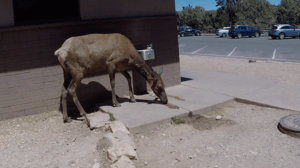
The conifer forests are home to 52 animal species. Porcupines, red squirrels, tassel-eared Kaibab and Abert's squirrels, black bear, mule deer, and elk are found at higher elevations.
Above the desert scrub, up to 6,200 feet (1,900 m), is a pinyon pine and juniper woodland. Here you can find big sagebrush, Mormon tea, and various Yucca plants. The Greater short-horned lizard is very common in these forests.
Ponderosa pine forests grow between 6,500 and 8,200 feet (2,000 and 2,500 m) on both rims. You'll see species like gray fox, mule deer, and bighorn sheep. The Tiger salamander and Great Basin spadefoot toad are common amphibians here. Many bird species also breed in these forests.
Canadian and Hudsonian Zones
Elevations from 8,200 to 9,000 feet (2,500 to 2,700 m) are in the Canadian Life Zone. This includes the North Rim and the Kaibab Plateau. Here, you'll find spruce-fir forests with Engelmann spruce, Douglas fir, and aspen trees. Mountain lions, Kaibab squirrels, and American goshawks live here.
Montane meadows and subalpine grasslands are rare. They are found only on the North Rim. These areas have many types of grasses like blue and black grama. Wet areas also support sedges and other plants.
Grand Canyon Tourism and Activities
Grand Canyon National Park is one of the world's most popular natural attractions. It draws about five million visitors each year. Most visitors are from the United States, but many also come from other countries like the United Kingdom, Canada, and Japan.
The South Rim is open all year, if the weather allows. The North Rim is usually open from mid-May to mid-October.
Things to Do and See
There are many great viewing points around the canyon. The easiest ones to reach are in Grand Canyon National Park and the Hualapai Indian Reservation. About 90% of tourists visit the South Rim, which is about 7,000 feet (2,100 m) above sea level. The South Rim has two visitor centers, a museum, an art gallery, and other attractions near Grand Canyon Village. Further east is the Desert View Watchtower.
The North Rim also has a visitor center. It is reached via Arizona State Route 67 but closes in winter due to snow. On the Hualapai reservation, Grand Canyon West is another popular tourist area. It's about 125 mi (201 km) from Las Vegas. The tribe opened the glass-bottomed Grand Canyon Skywalk in 2007. This attracts thousands of visitors each year.
Rafting, hiking, running, and helicopter tours are also popular. You can reach the bottom of the canyon by foot, mule, or by boat on the river. Park officials advise against hiking down to the river and back up in one day. This is because of the long distance, steep trails, and high temperatures at the bottom. Many people need rescue if they try this. However, many fit and experienced hikers complete the trip safely.
Camping on the North and South rims is usually in special campgrounds. Reservations are highly recommended, especially at the busy South Rim. All overnight camping below the rim needs a special permit. The park gets about 30,000 requests for permits each year.
For a view from above, you can go skydiving or take helicopter and small airplane tours. These scenic flights are not allowed to fly too close to the rim within the national park. However, some helicopter flights land on the Havasupai and Hualapai Indian Reservations outside the park.
In 2016, skydiving became possible at the Grand Canyon National Park Airport.
See also
 In Spanish: Gran Cañón para niños
In Spanish: Gran Cañón para niños
Images for kids
-
South Kaibab Trail at Cedar Ridge. O'Neill Butte on the left.


